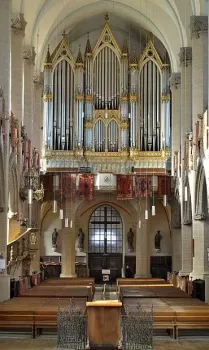
P2P | 14 September 2024 | 22.53 GB
描述:该乐器是卡尔·奥古斯特·布赫霍尔茨(1796 – 1884)现存最大的管风琴,他是一位多产的柏林管风琴制造者。它由四个手动控制台和63个寄存器组成。黑教堂(Biserica neagra, Schwarze Kirche)是位于特兰西瓦尼亚(今天的罗马尼亚)中心的路德教会。自12世纪以来,特兰西瓦尼亚就有德国殖民者,自路德教在欧洲开始以来,德国路德教的传统一直没有中断。布拉索夫是这座教堂管风琴的中心。教堂以其独特的土耳其地毯收藏而闻名,这些地毯挂满了墙壁和各处,它们无疑也为哥特式建筑的声学效果做出了贡献。风琴是罗马尼亚最大的机械乐器。频繁的音乐会强调了乐器的重要性:从春季到秋季,每周举行三场管风琴音乐会。
这种类型的乐器有时被称为“间隔时间”。它有一个浪漫的声音的明显迹象:占主导地位的8英尺停止,多合唱设计的部门,充分发展唱诗班(长笛,弦乐,主,芦苇)在每个部门,强烈的动态对比的部门。然而,它仍然植根于巴洛克式管风琴的设计,其“Werkprinzip”和金字塔结构(主止点,分配器,混合物)。这个管风琴的核心是来自柏林圣母教堂的约阿希姆·瓦格纳的管风琴,布赫霍尔茨在1829年对它进行了翻新。纯机械动作驱动传统的滑动箱子,需要很大的力量在键盘上演奏。
管风琴在物理上被设计在三层:底部由踏板占据,管风琴体的两侧有最高的管道。Oberwerk位于前面的地板上,这导致了直接和真实的声音。后台位于后面,是封闭的,具有真正的回声室的特点。上层是Hauptmanual(在前面)和Rohrwerk(在后面,关闭),你可以听到一个有点遥远,几乎神秘的声音从上面传来。寄存器的颜色彼此完美匹配,创造了一个真正平滑的渐强,没有寄存器(即使是最响亮的)从黑暗和沉重的tutti中脱颖而出。
这架风琴建于1839年,是早期浪漫主义风格。它至今没有大的变化。
Description : The instrument is the largest surviving organ of Carl August Buchholz (1796 – 1884), a prolific Berlin organ builder. It consists of four manual consoles with 63 registers. The Black Church (Biserica neagra, Schwarze Kirche) is a Lutheran church in the heart of Transylvania (today Romania). Transylvania had German colonists since the 12th century, and there has been an uninterrupted German Lutheran tradition since the beginning of Lutheranism in Europe. Brasov is the center of this church organ. The church is famous for its unique collection of historical Turkish carpets, which hang all over the walls and throughout – and they also undoubtedly contribute to the acoustics of the Gothic building. The organ is the largest mechanical instrument in Romania. The importance of the instrument is emphasized by frequent concerts: from spring to autumn, three organ concerts are held every week.
The type of instrument is sometimes called “between times”. It has clear signs of a romantic sound: the dominance of 8-foot stops, the polychoric design of the divisions, fully developed choirs (flutes, strings, principals, reeds) in each division, strong dynamic contrasts between the divisions. However, it still has its roots in the design of the Baroque organ with its “Werkprinzip” and pyramidal structure (main stops, aliquots, mixtures). The core of this organ is the Joachim Wagner organ from the Marienkirche in Berlin, an organ that Buchholz renovated in 1829. The purely mechanical action drives traditional slide chests, requiring a lot of force to play on the keyboard.
The organ is physically designed on three floors: the base is occupied by the pedal with the highest pipes on the sides of the organ body. The Oberwerk is located on the floor above at the front, which results in a direct and real sound. The Unterwerk is at the back, closed and has the characteristics of a real echo compartment. The upper floor belongs to the Hauptmanual (at the front) and the Rohrwerk (at the back, closed), which allows you to hear a somewhat distant, almost mystical sound from above. The colors of the registers match each other perfectly, creating a truly smooth crescendo, where no register (even the loudest) stands out from the dark and heavy tutti.
The organ was built in 1839 in the early romantic style. It has survived without major changes to this day.
![Jinobeats Monólithos (MOTM Vital Preset Pack) [Synth Presets]](http://www.bianquzy.com/wp-content/uploads/2025/10/Jinobeats-Monolithos-MOTM-Vital-Preset-Pack-Synth-Presets.jpg)
![Hozay Williams and Franky Confessions (Compositions and Stems) [WAV]](http://www.bianquzy.com/wp-content/uploads/2025/10/Hozay-Williams-and-Franky-Confessions-Compositions-and-Stems-WAV.jpg)
![爵士风格音色 Steinberg Jazz Essentials [Halion]](http://www.bianquzy.com/wp-content/uploads/2025/10/Steinberg-Jazz-Essentials-Halion.jpg)
![非洲浩室 Infinity Audio Jungle Groove Afro House [WAV, MiDi]](http://www.bianquzy.com/wp-content/uploads/2025/10/Infinity-Audio-Jungle-Groove-Afro-House-WAV-MiDi.jpg)
![Toolroom Jewel Kid Trademark Series [WAV]](http://www.bianquzy.com/wp-content/uploads/2025/10/Toolroom-Jewel-Kid-Trademark-Series-WAV.jpg)
![Haven Audio Private Sounds Hardware-Sourced Analog Lab Bank [Synth Presets]](http://www.bianquzy.com/wp-content/uploads/2025/10/Haven-Audio-Private-Sounds-Hardware-Sourced-Analog-Lab-Bank-Synth-Presets.jpg)
